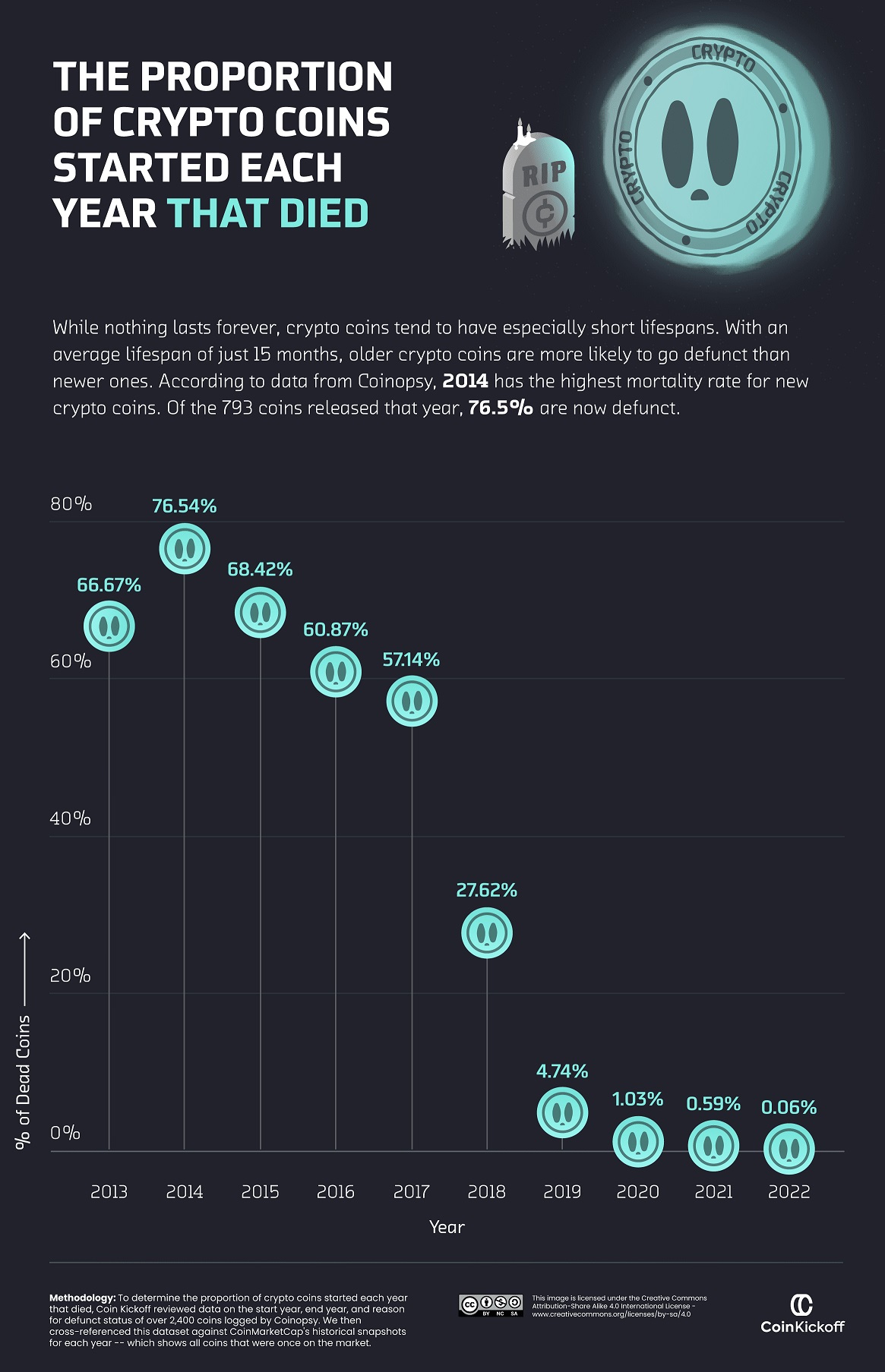Ever since the first major crypto boom in 2011, tens of thousands of cryptocurrency coins have been released to market.
And while some cryptocurrencies performed well, others have ceased to trade or have ended up as failed or abandoned projects.
These graphics from CoinKickoff break down the number of failed crypto coins by the year they died, and the year they started. The data covers a decade of coin busts from 2013 through 2022.
Q1 2023 hedge fund letters, conferences and more

Methodology
What is the marker of a “dead” crypto coin?
This analysis reviewed data from failed crypto coins listed on Coinopsy and cross-referenced against CoinMarketCap to verify previous market activity. The reason for each coin death was also tabulated, including:
- Failed Initial Coin Offerings (ICOs)
- Abandonment with less than $1,000 in trade volume over a three-month period
- Scams or coins that were meant as a joke
Dead Crypto Coins from 2013 to 2022
While many familiar crypto coins—Litecoin, Dogecoin, and Ethereum—are still on the market today, there were at least 2,383 crypto coins that bit the dust between 2013 and 2022.
Here’s a breakdown of how many crypto coins died each year by reason:
| Dead Coins by Year |
Abandoned / No Volume |
Scams / Other Issues |
ICO Failed / Short-Lived |
Joke / No purpose |
|---|---|---|---|---|
| 2013 | 9 | 0 | 0 | 0 |
| 2014 | 277 | 20 | 5 | 2 |
| 2015 | 223 | 27 | 1 | 2 |
| 2016 | 152 | 22 | 4 | 5 |
| 2017 | 169 | 71 | 46 | 6 |
| 2018 | 390 | 237 | 112 | 12 |
| 2019 | 203 | 73 | 51 | 2 |
| 2020 | 77 | 19 | 9 | 0 |
| 2021 | 34 | 36 | 2 | 2 |
| 2022 | 50 | 23 | 8 | 2 |
| Total | 1,584 | 528 | 238 | 33 |
Abandoned coins with flatlining trading volume accounted for 1,584 or 66.5% of analyzed crypto failures over the last decade. Comparatively, 22% ended up being scam coins, and 10% failed to launch after an ICO.
As for individual years, 2018 saw the largest total of annual casualties in the crypto market, with 751 dead crypto coins. More than half of them were abandoned by investors, but 237 coins were revealed as scams or embroiled in other controversies, such as BitConnect which turned out to be a Ponzi scheme.
Why was 2018 such a big year for crypto failures?
This is largely because the year prior saw Bitcoin prices climb above $1,000 for the first time with an eventual peak near $19,000. As a result, speculation ran hot, new crypto issuances boomed, and many investors and firms got bullish on the market for the first time.
How Many Newly Launched Coins Died?
Of the hundreds of coins that launched in 2017, more than half were considered defunct by the end of 2022.

Indeed, a lot of earlier-launched coins have since died. The majority of coins launched between 2013 and 2017 have already become “dead coins” by the end of 2022.
| Coin Start Year | Dead Coins by 2022 |
|---|---|
| 2013 | 66.67% |
| 2014 | 76.54% |
| 2015 | 68.42% |
| 2016 | 60.87% |
| 2017 | 57.14% |
| 2018 | 27.62% |
| 2019 | 4.74% |
| 2020 | 1.03% |
| 2021 | 0.59% |
| 2022 | 0.06% |
Part of this is because the cryptocurrency field itself was still being figured out. Many coins were launched in a time of experimentation and innovation, but also of volatility and uncertainty.
However, the trend began to shift in 2018. Only 27.62% of coins launched in that year have bit the dust so far, and the failure rates in 2019 and 2020 fell further to only 4.74% and 1.03% of launched coins, respectively.
This suggests that the crypto industry has become more mature and stable, with newer projects establishing themselves more securely and investors becoming wiser to potential scams.
How will this trend evolve into 2023 and beyond?

